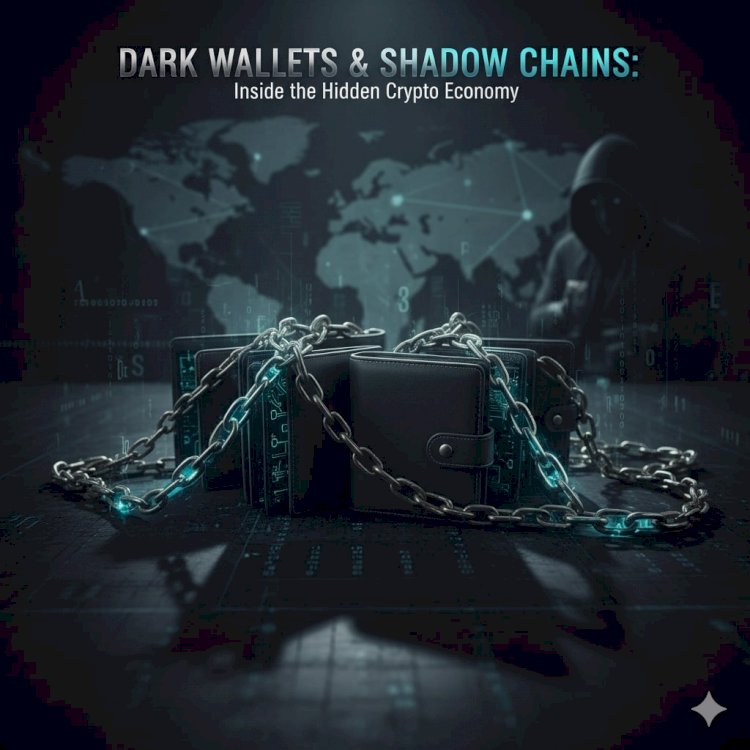Dark Wallets and Shadow Chains: Inside the Hidden Crypto Economy

By Dr. Pooyan Ghamari, Swiss Economist and Visionary
In the shimmering underbelly of the digital age, where blockchain's promise of transparency collides with humanity's eternal quest for secrecy, lies a parallel universe fueled by cryptocurrency. This is the hidden crypto economy—a shadowy realm where transactions whisper through encrypted veils, fortunes are forged in anonymity, and innovation dances on the edge of illegality. As a Swiss economist with a PhD in Banking and Finance, I've long observed how financial systems evolve, from the gold-backed stability of old Europe to the volatile freedoms of decentralized ledgers. Today, dark wallets and shadow chains represent the vanguard of this evolution: tools that empower the privacy-conscious while tempting the unscrupulous. But what exactly are they, and why do they matter in a world increasingly surveilled by algorithms and regulators?
This article peels back the layers of this clandestine ecosystem, drawing on the latest developments as of November 2025. We'll explore the mechanics of dark wallets, the elusive architecture of shadow chains, and the broader implications for global finance. In doing so, we confront a paradox: these technologies could liberate individuals from overreach, yet they also grease the wheels of cybercrime. As someone who's championed ethical AI and sustainable wealth management through platforms like ALand, I believe understanding this shadow world is key to shaping a more equitable digital future.
The Enigma of Dark Wallets: Anonymity in Your Pocket
Imagine a wallet not for cash or cards, but for code—code that doesn't just store value but actively conceals it. Dark wallets are the stealth fighters of cryptocurrency storage, designed to obscure user identities, transaction histories, and even the very flow of funds far beyond what standard Bitcoin or Ethereum wallets allow. Unlike transparent blockchains, where every transfer is etched in public stone, dark wallets employ advanced obfuscation techniques to render your digital footprint ghostly.
The concept gained notoriety in 2014 with the launch of Dark Wallet, a browser extension developed by anarcho-libertarian coder Amir Taaki and gun-rights activist Cody Wilson. This tool wasn't just a storage device; it was a manifesto. Built for Windows, Mac, and Linux, it integrated coin mixing—pooling transactions from multiple users to break traceability—and even "plausible deniability" features, allowing users to hide the true balance of their holdings. Wilson famously pitched it as a "radical way to Bitcoin," a counterweight to governments' growing ability to track funds via chain analysis firms.
Fast-forward to 2025, and dark wallets have evolved into sophisticated ecosystems. Privacy coins like Monero (XMR) dominate this space, using ring signatures and stealth addresses to make transactions untraceable. Wallets such as Wasabi or Samourai Wallet for Bitcoin incorporate CoinJoin protocols, where users collaborate to mix their coins, emerging with "clean" funds indistinguishable from legitimate ones. Hardware variants, like Ledger or Trezor with privacy plugins, add physical security, though they've drawn scrutiny for potential exploits that could siphon millions in illicit crypto undetected.
But here's the double-edged sword: while activists in authoritarian regimes use dark wallets to evade censorship—think dissidents funneling donations without reprisal—these tools supercharge the dark web's bazaars. On platforms like the successors to Silk Road, stolen crypto accounts fetch premiums: a verified Coinbase hack goes for $610, while Kraken breaches command $810. Phishing "drainers"—malicious smart contracts disguised as legit DeFi apps—lure victims into approving fraudulent transfers, draining wallets in seconds. In 2025, with cybercrime costs projected to hit $10.5 trillion annually, dark wallets aren't just accessories; they're enablers of a subterranean economy where anonymity is currency.
From my vantage in Switzerland, a nation synonymous with discreet banking, I see echoes of our vaulted past in these digital fortresses. Yet, as regulators like the EU's MiCA framework tighten KYC (Know Your Customer) requirements, dark wallets force a reckoning: How do we balance privacy with accountability?
Shadow Chains: The Invisible Threads of Decentralized Secrecy
If dark wallets are the masks, shadow chains are the hidden stages where the performance unfolds. These are not your everyday blockchains; they're parallel, permissioned networks that settle value in the penumbra, away from prying eyes. Coined in fintech circles, "shadow chains" refer to private ledgers that mirror public ones but operate off the main grid, enabling confidential transactions without broadcasting to the world.
Take Shadow Chain, a Web3 privacy protocol launched in late 2024, which shields wallet addresses, obfuscates on-chain communications, and allows anonymous dealings—all while interfacing seamlessly with Ethereum or Solana. It's not alone. Platforms like Shadow.xyz employ "shadow forks"—real-time replicas of public blockchains in isolated environments—to query data privately, powering everything from high-frequency trading bots to forensic tools for investigators. Then there are enterprise shadow chains: consortia of banks and corporates building bespoke settlement rails, bypassing slow legacy systems like SWIFT for instant, confidential cross-border transfers.
In the wilder fringes, shadow chains manifest as decentralized storage for logs and data, like the Shadow-Chain protocol proposed in academic papers, which uses blockchain to share audit trails without exposing sensitive details. Picture this: A cartel laundering proceeds through a shadow chain layered atop Monero, where transactions settle in a private subnet before "exiting" to the main chain as clean fiat via over-the-counter desks. Or DeFi protocols running shadow liquidity pools, where whales trade massive volumes without market slippage.
This architecture thrives in the hidden crypto economy because it exploits blockchain's modularity. Layer-2 solutions like Polygon or Optimism already hint at this, but shadow variants go darker: zero-knowledge proofs (ZKPs) verify transactions without revealing inputs, and homomorphic encryption lets computations occur on encrypted data. The result? A web of invisible threads sustaining everything from ransomware payouts—up 20% in 2025—to insider trading in tokenized assets.
As an economist attuned to systemic risks, I view shadow chains as both a boon and a boondoggle. They could democratize finance for the unbanked, settling remittances in shadows free from predatory fees. Yet, in the hands of illicit actors, they amplify opacity, with privacy coins like Monero seeing 300% spikes in dark web volume during major breaches.
The Pulse of the Hidden Economy: Cybercrime, Laundering, and Beyond
Tie dark wallets to shadow chains, and you get the hidden crypto economy in full bloom—a $1.5 trillion shadow market by some 2025 estimates, dwarfing traditional dark pools in stocks. The dark web, that Tor-encrypted corner of the internet, pulses with activity: marketplaces hawking stolen SSNs for $1–$6, bank logins at $200–$1,000, and full crypto accounts north of $1,100. Cryptocurrencies, especially privacy-focused ones, are the lifeblood here, concealing flows much like the dark web hides traffic.
Money laundering is the dark art perfected in this realm. Illicit actors "mix" funds through dark wallets, route them via shadow chains to obfuscate origins, then tumble them back into fiat through exchanges with lax compliance—or worse, "crypto laundering as a service" booths on the dark web. Recent busts, like the 2025 takedown of a Monero mixer ring, revealed $500 million in laundered ransomware, underscoring the scale. Cybercriminals don't just sell data; they build empires, with fresh breach dumps spiking prices by 50% in supply-demand frenzy.
Yet, this economy isn't pure malice. Privacy advocates argue it's a bulwark against surveillance capitalism—think whistleblowers funding ops via shadow chains or activists dodging state trackers. In Switzerland, where banking secrecy is cultural DNA, I see parallels: These tools extend that ethos globally, but at what cost?
Navigating the Shadows: Risks, Regulations, and a Vision Forward
The hidden crypto economy isn't static; it's a hydra. Regulators strike at one head—say, the U.S. Treasury's 2024 crackdown on Tornado Cash mixers—and two grow back in decentralized forms. By 2025, the EU's AI Act and Travel Rule amendments mandate transaction tracing, pushing innovators toward compliant "light shadow" chains. But enforcement lags: Only 10% of dark web crypto flows are flagged.
Risks abound. Users face "wallet drainers" that exploit approvals, while investors grapple with volatility amplified by shadow liquidity dumps. Economically, this underbelly erodes trust, inflating compliance costs for legit firms by 15%.
As a visionary in finance, I propose a middle path: Hybrid frameworks blending ZKPs for voluntary transparency. Platforms like my ALand initiative already tokenize real estate with privacy toggles—imagine extending that to crypto. By fostering ethical shadow tools, we can harness anonymity for good, from humanitarian aid to carbon credit trading, without feeding the beast.
In the end, dark wallets and shadow chains remind us that technology is neutral; intent is king. The hidden crypto economy is our mirror—reflecting desires for freedom, fears of exposure, and the endless tug-of-war between light and dark. As we peer deeper, let's not avert our eyes, but illuminate wisely.
Dr. Pooyan Ghamari is a Swiss economist, AI specialist, and founder of ALand, revolutionizing real estate and gold markets through innovative platforms.

 content-team
content-team 
















